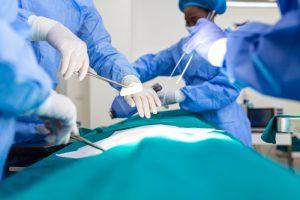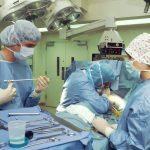-
Gallbladder Removal St. Peters: Surgery & Aftercare | BenrusSurgical.com
If you’re tired of the discomfort caused by acute cholecystitis, benrussurgical.com has the solution you’ve been searching for. With our experienced surgeons and skilled surgeons, say farewell to the pain and inconvenience of acute cholecystitis in St. Peters. Our experienced team of skilled surgeons is dedicated to providing effective and personalized care, ensuring a smooth experience from consultation to recovery.
From understanding the procedure to post-operative tips, this blog will guide you through everything you need to know about gallbladder removal at St. Peters’ Benrus Surgical Associates. Whether it’s addressing common concerns or shedding light on what sets us apart, our team has all your questions covered. Get ready to take charge of your health and bid adieu to gallbladder troubles once and for all.
Recognizing Symptoms
Recognizing the symptoms is crucial for seeking timely medical care. Sudden, intense pain in the upper right abdomen is a common indicator of gallbladder problems. This sharp pain can persist for several minutes or even hours and may radiate to the back or the right shoulder.

Nausea and vomiting after meals are also telltale signs of gallbladder complications. These symptoms occur due to the inability of the body to properly digest fats as a result of reduced bile flow from the gallbladder. Individuals experiencing back pain between their shoulder blades might be suffering from gallbladder issues.
Minimally invasive techniques have revolutionized gallbladder removal treatment, offering patients less invasive options with quicker recovery times. Unlike open surgery, which requires a large incision in the abdomen, laparoscopic cholecystectomy involves making small incisions through which specialized surgical tools and a tiny camera are inserted.
Robotic-assisted gallbladder removal represents another minimally invasive approach that leverages advanced technology for enhanced precision and control during surgery. By utilizing robotic arms controlled by surgeons, this technique allows for greater dexterity and maneuverability within confined spaces compared to traditional laparoscopic methods.
Understanding Gallbladder Disease
Causes and Diagnosis
Gallbladder disease is often caused by the formation of gallstones in the gallbladder, leading to various complications. These small, hardened deposits can block the bile ducts or cause inflammation, resulting in severe pain and discomfort for individuals. When these symptoms become evident, it’s crucial to seek medical care promptly.
Diagnosing gallbladder disease typically involves a combination of ultrasound imaging and blood tests. Ultrasound scans help healthcare providers visualize any abnormal growths or blockages within the gallbladder or bile ducts. Blood tests are also conducted to check for elevated levels of certain enzymes that may indicate inflammation or infection in the organ.
Gallbladder removal surgery, also known as cholecystectomy, is often recommended when non-surgical treatments fail to alleviate symptoms effectively. This minimally invasive procedure offers reduced scarring and pain post-surgery compared to traditional open surgery methods. Patients experience a faster recovery time with a lower risk of complications.
Non-Surgical Treatments
Non-surgical treatments for gallstones primarily focus on addressing their presence within the gallbladder before they lead to more serious issues such as blockage of the bile ducts. Lifestyle modifications like dietary changes may be suggested by healthcare professionals to prevent further stone formation.
In some cases where gallstones cause significant discomfort but surgery isn’t immediately necessary, medications may be prescribed temporarily to dissolve them over time. However, it’s essential for individuals with this condition to consult closely with their doctors regarding suitable treatment options based on their specific circumstances.
Laparoscopic Gallbladder Surgery
Procedure Overview
Gallbladder removal, also known as gall bladder surgery, is a common procedure to address issues such as acute cholecystitis. When medications fail to dissolve gallstones or lifestyle changes don’t effectively manage symptoms, surgical intervention may be necessary. Adopting a low-fat diet can help reduce the formation of gallstones.
During the surgery, the surgeon makes small incisions in the abdomen and uses a laparoscope for visualization. This minimally invasive approach allows for the safe and effective removal of the gallbladder. It’s important to note that this procedure is commonly performed by a general surgeon with expertise in general colon procedures and abdominal pain management.
Safety and Efficacy
The use of a laparoscope during gallbladder removal enables surgeons to navigate and operate with precision while minimizing trauma to surrounding tissues. This results in reduced scarring, shorter recovery times, and less post-operative discomfort for patients.
Moreover, this method has been proven to be a safe and effective treatment option for various gallbladder issues like acute cholecystitis or bile duct problems. Patients undergoing this surgical procedure can expect minimal complications and faster recuperation compared to traditional open surgeries.
Traditional vs Laparoscopic Surgery
Comparing Techniques
Gallbladder removal surgery, whether traditional or laparoscopic, boasts a high success rate. This means that the procedure is generally effective in removing the gallbladder without complications. In traditional open surgery, a larger incision is made to access and remove the gallbladder, while in laparoscopic surgery, several small incisions are used for specialized tools and a camera. The smaller incisions of laparoscopic surgery often result in minimal scarring and quicker recovery times.
Both techniques have their advantages. With laparoscopic surgery, there’s typically minimal risk of bile duct injury due to the precision offered by advanced instruments and imaging technology. On the other hand, traditional open surgery may pose slightly higher risks due to its invasive nature.
Post-surgery quality of life also favors laparoscopic techniques due to their minimally invasive nature. Patients who undergo this type of procedure often experience less pain after surgery and have shorter hospital stays compared to those who undergo traditional open procedures.

Factors in Surgical Choice
The choice between open surgical techniques like cholecystectomy (gallbladder removal) versus laparoscopy depends on various factors such as patient health status, surgeon preference, and individual anatomical considerations. Robotic-assisted surgeries are gaining popularity for certain patients due to their potential benefits.
Open cholecystectomy involves making a large abdominal incision which allows direct access to the gallbladder but can lead to longer recovery times and increased post-operative pain compared with minimally invasive approaches like laparoscopy or robotic-assisted methods.
Laparoscopic techniques offer numerous benefits over traditional open surgeries including reduced post-operative pain, faster recovery times leading back into normal daily activities sooner than with an open approach; however it might not be suitable for all patients based on specific medical conditions or previous abdominal surgeries they’ve undergone.
Choosing Your Surgeon in St. Peters
Criteria for Selection
When choosing a surgeon in St. Peters for gallbladder removal, several criteria should be considered. The patient’s overall health and medical history play a crucial role in determining the suitability of the procedure. Factors such as the size and number of gallstones also influence the choice between traditional and laparoscopic surgery.
The surgeon’s expertise in different techniques is another critical aspect to consider when selecting a healthcare professional for gallbladder removal. A skilled surgeon will have experience with both traditional open surgery and minimally invasive laparoscopic procedures, allowing them to provide personalized recommendations based on the patient’s specific condition.
Benrus Surgical Expertise
Benrus Surgical offers specialized expertise in gallbladder removal procedures, ensuring that each patient receives an individualized assessment by a dedicated surgical team. This comprehensive evaluation takes into account the patient’s overall health, medical history, and specific characteristics of their gallstones.
Moreover, at Benrus Surgical, patients have the opportunity to engage in thorough discussions about their treatment options with the surgical team. By involving patients in these conversations, they can make well-informed decisions about their care plan based on their preferences and comfort level with different surgical approaches.
In addition to considering various factors related to the patient’s health and medical history, Benrus Surgical places significant emphasis on accommodating patient preferences when developing tailored treatment plans for gallbladder removal procedures.
Recovery and Aftercare
Post-Surgery Recovery
After undergoing gallbladder removal at St. Peters, the recovery phase is crucial. The surgical team at Benrus Surgical specializes in minimally invasive procedures, ensuring a quicker recovery for patients. With their advanced training, they provide exceptional care focused on the patient’s well-being.
The experienced surgical team at Benrus Surgical is committed to providing specialized care during your recovery. They prioritize patient-centered care, offering detailed instructions for at-home care to ensure a smooth recuperation process. From pain management strategies to guiding you through dietary adjustments, their focus remains on your comfort and healing.
Dietary Adjustments
Following gallbladder removal, it’s essential to make dietary adjustments that align with your body’s needs post-surgery. At Benrus Surgical in St. Peters, patients receive comprehensive guidance on managing their diet after the procedure. You’ll be provided with detailed instructions tailored to support your recovery journey effectively.
In addition to dietary guidance, pain management strategies are implemented as part of the aftercare plan following gallbladder removal surgery. This ensures that you can rest and recover comfortably without unnecessary discomfort or complications arising from the procedure. Moreover, a clear timeline for returning to normal activities will be outlined by the medical team based on individual progress and healing.
Risks of Gallbladder Removal
Potential Complications
After gallbladder removal st. peters surgery, patients are typically advised to follow a low-fat diet to aid in digestion and prevent discomfort. This is because the gallbladder plays a role in digesting fats, and without it, the body may struggle to process high-fat foods.
Avoiding certain foods that may trigger symptoms is also crucial post-surgery. For example, some people find that spicy or greasy foods can lead to digestive issues after gallbladder removal. It’s important for individuals to pay attention to how their bodies react to different types of food and make adjustments accordingly.
Balanced nutrition is vital for overall health after gallbladder removal. Patients should focus on consuming a variety of nutrient-rich foods including fruits, vegetables, lean proteins, and whole grains. Adequate hydration is also essential for supporting the body’s recovery process.
Importance of Timely Treatment
There are risks associated with both anesthesia and surgery when undergoing gallbladder removal procedures. Anesthesia complications can include allergic reactions or adverse effects on breathing or heart function during the procedure.
Following surgery, there is a potential risk of bile leakage or infection at the site where the gallbladder was removed. These complications require prompt medical attention to prevent further health issues from developing.
Monitoring for signs of complications such as persistent abdominal pain, fever, chills, jaundice (yellowing of the skin), or abnormal bowel movements is critical post-surgery. Early detection allows healthcare providers to intervene promptly if any problems arise.
Life After Gallbladder Removal
Long-Term Management
After gallbladder removal, it’s crucial to focus on long-term management to prevent worsening symptoms. Early intervention is key, so if you experience persistent pain or digestive issues, consult a healthcare provider promptly. Ignoring these symptoms can lead to complications from untreated gallbladder issues.
Community Health Support Following the surgery, regular follow-up appointments with your healthcare provider are essential for monitoring your overall health and well-being. Making lifestyle modifications can significantly contribute to your overall wellness post-surgery. These modifications may include dietary adjustments and maintaining a healthy weight.
Education plays a vital role in helping individuals adapt to their new normal. Learning about how the body digests food without a gallbladder and understanding which foods may trigger discomfort is crucial for effectively managing these changes.
Advanced Surgical Technologies
Innovations at Benrus
At Benrus Surgical, patients undergoing gallbladder removal can benefit from a range of innovative support services. These include dedicated support groups designed to provide emotional and practical assistance for individuals facing the prospect of surgery. The hospital also offers comprehensive educational resources for both patients and their families, ensuring that everyone involved has access to essential information about the procedure, recovery process, and potential outcomes.
Moreover, Benrus Surgical emphasizes collaboration with local healthcare providers to ensure a seamless experience for patients requiring gallbladder removal. This collaborative approach helps in providing holistic care by involving various medical professionals who work together to address different aspects of patient needs during pre-operative assessments, surgical procedures, and post-operative care.

Impact on Patient Care
The impact of these innovations is significant. By leveraging state-of-the-art technology for surgical procedures, skilled surgeons at Benrus are able to perform complex surgeries such as gallbladder removal with precision and minimal invasiveness. This results in reduced trauma for the patient’s body and faster recovery times.
Ongoing research efforts contribute to improved treatment outcomes for individuals undergoing gallbladder removal. By collaborating with leading medical professionals in the field of gastroenterology and surgery, Benrus stays abreast of advancements in techniques related to duct management during gallbladder removal surgeries.
Scheduling with Benrus Surgical
Contact Information
When scheduling gallbladder removal at St. Peters, Benrus Surgical offers personalized care plans tailored to individual needs. This means that each patient receives a treatment plan designed specifically for them, taking into account their unique medical history and requirements. The focus on personalized care ensures that patients feel supported and understood throughout their surgical journey.
Moreover, Benrus Surgical prioritizes patient education and empowerment. This approach involves thoroughly explaining the gallbladder removal procedure to patients, addressing any concerns or questions they may have, and involving them in decision-making processes regarding their treatment. By empowering patients with knowledge about their condition and the surgical process, Benrus Surgical helps alleviate anxiety and fosters a sense of control over one’s health.
In addition to personalized care plans and patient education, Benrus Surgical adopts a holistic approach to support overall well-being. This includes considering not only the physical aspects of gallbladder removal but also the emotional and mental well-being of patients. By providing comprehensive support before, during, and after surgery, Benrus Surgical aims to ensure that patients feel cared for on all levels.
Medical Forms Submission
For individuals seeking gallbladder removal at St. Peters through Benrus Surgical, there is a direct line available for scheduling consultations. This streamlined process enables prospective patients to easily connect with the surgical team to discuss their medical needs and schedule appointments without unnecessary delays.
Furthermore, those with general inquiries about gallbladder removal can reach out directly through this contact information channel provided by Benrus Surgical‘s website or office location in St. Peters.
Individuals considering gallbladder removal may have questions related to insurance coverage for the procedure.
Summary
You’ve now gained a comprehensive understanding of gallbladder removal, from recognizing symptoms to life after the surgery. Whether you opt for traditional or laparoscopic surgery, the key is choosing a skilled surgeon in St. Peters. Your journey doesn’t end with the operation; it’s crucial to prioritize recovery and aftercare to ensure a smooth transition into life without a gallbladder. Benrus Surgical offers advanced surgical technologies, making them a top choice for your procedure.
Now that you’re equipped with this knowledge, take the next step and schedule a consultation with Benrus Surgical. Your proactive approach to managing gallbladder disease will set you on the path to improved health and well-being.
Frequently Asked Questions
What are the common symptoms of gallbladder disease?
The common symptoms of gallbladder disease include abdominal pain, nausea, vomiting, and bloating after meals. These symptoms can be persistent and may indicate the need for medical evaluation.
How is laparoscopic gallbladder surgery different from traditional surgery?
Laparoscopic gallbladder surgery involves smaller incisions and a faster recovery time compared to traditional open surgery. It is less invasive and generally results in less pain and scarring.
What should I consider when choosing a skilled surgeon in St. Peters for gallbladder removal?
When choosing a surgeon for your gallbladder removal, consider their experience, credentials, patient reviews, and communication style. A skilled and compassionate surgeon can make a significant difference in your surgical experience.
What are the risks associated with gallbladder removal?
Risks of gallbladder removal include infection, bleeding, injury to nearby organs, bile duct injury, and rare complications such as blood clots or pneumonia. Your surgeon will discuss these risks with you before the procedure.
What can I expect during the recovery period after gallbladder removal?
During the recovery period after gallbladder removal, patients may experience mild discomfort at incision sites and changes in digestion. Most people resume normal activities within a week following surgery.
